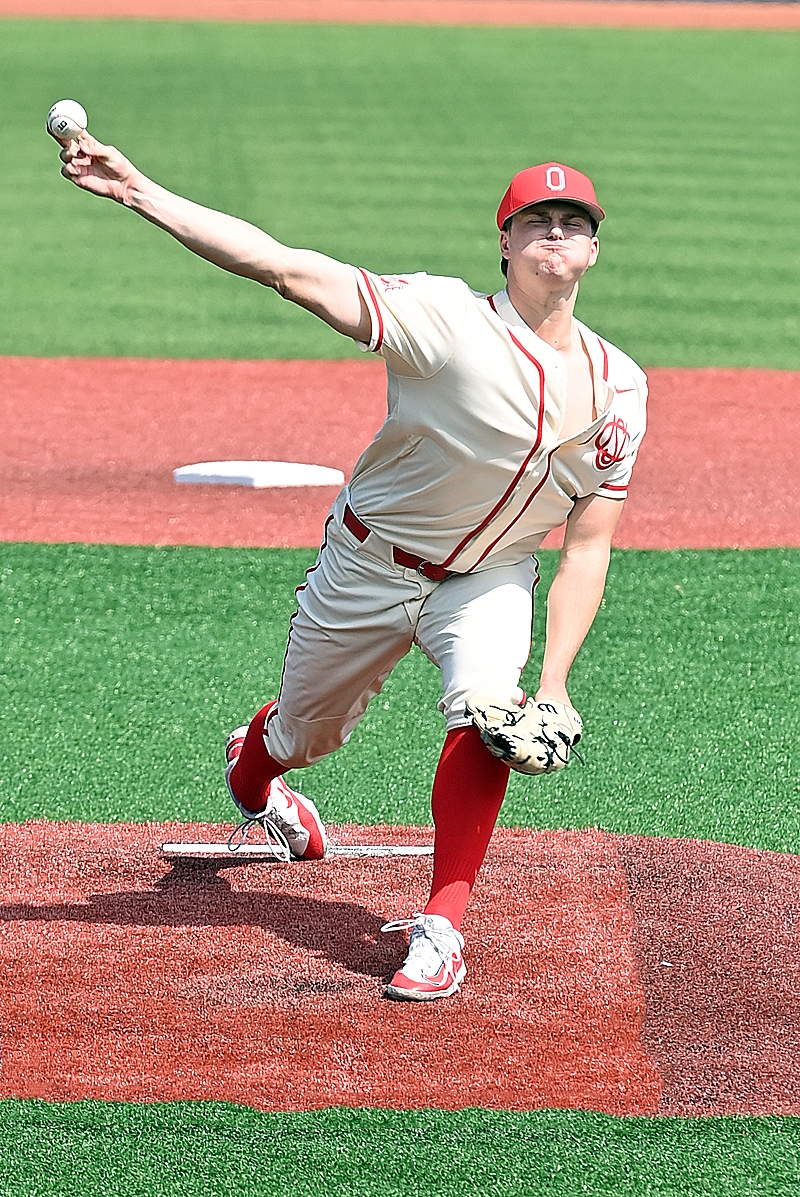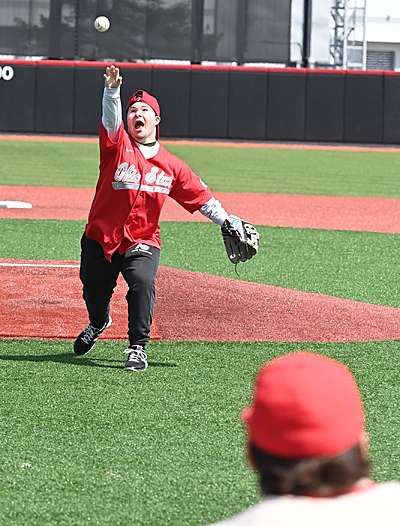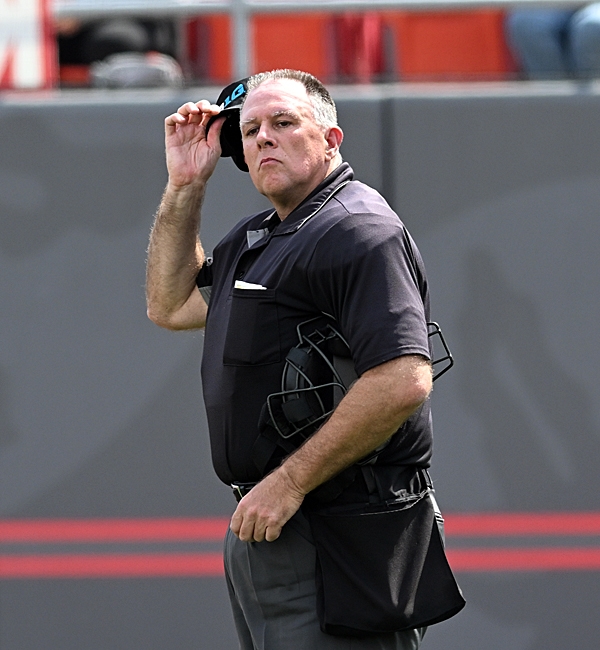
A lot of them got a shot on Sunday…freshman starter Gavin DeVooght got the default start and pitched two scoreless innings. (Press Pros Feature Photos)
It’s hard to win when you only get three hits and your freshman pitchers battle the batting order and the strike zone. Both gave rise to the Buckeyes dropping the series finale to Purdue.
 Columbus, OH – Simply put, the Ohio State Buckeyes didn’t play nearly well enough on Sunday to win.
Columbus, OH – Simply put, the Ohio State Buckeyes didn’t play nearly well enough on Sunday to win.
A day after scoring 12 runs on 15 hits with a walk-off home run to win 12-10, they dropped the series finale on Sunday to the Purdue Boilermakers, 7-1.
They had just 3 hits off a combination of Purdue starter Jonathan Blackwell and relievers Carter Doorn and Avery Cook, scored just one run in the fourth inning when they loaded the bases with no outs, and left them there when the three succeeding batters struck out, struck out, and popped up to third base.
“It’s awfully tough to win when you don’t hit and you walk 11 people,” said Bill Mosiello. “They could have scored a million runs with all the people we walked. But again, the bugaboo is not hitting with runners in scoring position and it’s a game changer in the fourth when you load the bases and don’t get a run, and two guys don’t even put a ball in play.
“That changed the ballgame because they tried to hand it to us, which is what we did for them. They just did a better job of getting hits than we did.”
At issue with the 11 walks was the strike zone of plate umpire Donald Goller, who drew the ire of both benches, but boiled over in the fifth when he ejected Ohio State bench coach Andrew See.
“It was bad for both teams,” said Mosiello. “But we didn’t lose a baseball game because of the umpire. These games are all on video, he had a super tight zone, and there was a lot of inconsistency. But again, he was, I guess, doing the best he could out there. But he wasn’t the reason [we lost].’

A big thrill on your birthday…Matt Stevenson, the brother of Buckeye centerfielder Josh Stevenson (foreground), threw out the first pitch prior to Sunday’s matinee.
Gavin DeVooght got the default start for the Buckeyes, who simply ran out of starting pitching after Friday and Saturday, and he delivered them an up-and-down, but scoreless first two innings.
Hunter Shaw came on in the third and lasted just one-third of an inning, faced seven hitters, and gave up 5 runs on 4 hits, while walking two.
Walks, to Mosiello’s statement, were a problem. More than once, as was the case on Saturday, Buckeye pitchers either walked the leadoff hitter…or the first hitter they faced upon entering the game.
Zak Sigman followed Shaw…Jacob Morin followed Sigman…Logan Jones followed Morin and delivered the most efficient two innings of the game…Blaine Wynk made an appearance…as did Zach Brown…and Justin Eckhardt pitched the ninth. The idea? Get some brush up work before a pair of mid-week games Kent State and next weekend’s road series with Nebraska.
Purdue won it with 7 runs on 10 hits and had no errors.
The Buckeyes dropped to 12-12 with 1 run on 3 hits and had one error.
Hunter Shaw was saddled with the loss, his second of the season without a win.
And Matt Graveline and Lipsey had the only two extra base hits for Ohio State, both doubles.
Game Notes
The unfortunate elephant in the room during Sunday’s finale was the umpiring crew of Donald Goller, Scott Wyckoff, Jim Schaly and Matt Neader. That, and a concern across the landscape of amateur baseball about from where the next generation of people are to come that can officiate a sport as subjective as baseball?
College umpiring has become a very lucrative business, and balls and strikes are usually the alpha and omega of discontent with the game, especially when the umpires make more working a game than most people make in a week of hard labor. And Goller, who called balls and strikes Sunday, was particularly tight behind the plate and that fact came to a head in the third inning when he ultimately heard it from the Ohio State bench.
But if he heard it he failed to address it, personally, and second base umpire Jim Schaly, the enforcer, eventually came to the foul line to throw out bench coach Andrew See.
An inning later it was the Purdue bench who was on Goller’s back – the same issue – over balls and strikes.
Umpires across college baseball now are particularly conservative when it comes to the strike zone, strictly enforcing that 17-inch rubber plate as if their umpiring life depends on it. And in fact, it probably does.

Plate umpire Don Goller called balls and strike for Sunday’s Ohio State vs. Purdue series finale.
This is the day of evaluation, and over-evaluation, where umpires at nearly every level are graded on how accurate they are with calling balls and strikes. The problem is, they’re still working for kids who are freshmen and sophomores and without the command of Greg Maddux – kids that are still learning to pitch. Squeeze the strike zone on them and it only makes the process tougher…on everyone.
“The strike zone probably should be bigger,” an assistant recently told me. “It would make for a better game.”
Unfortunately, as it did Sunday, it becomes about the umpire and not the game and the kids who play. More than one over the years has told me that if they want to work post-season they have to grade out well, and at the current rates they all want the distinction of being selected for an NCAA regional tournament, or the College World Series.
The problem is, despite being the Mount Rushmore of amateur baseball, college-age pitchers aren’t as good as Greg Maddux – and suffer by throwing a 90 mile-per-hour pitch that’s so close as to go either way…and have the plate umpire continually call it a ball, shouting so all can hear, ”its inside.” That’s exactly what got Andrew See ejected on Sunday.
And at the same time it doesn’t make anyone a more respected, or trusted, umpire. It is the $64,000 question at every level of sports. Officiating.
And where do we go from here?



